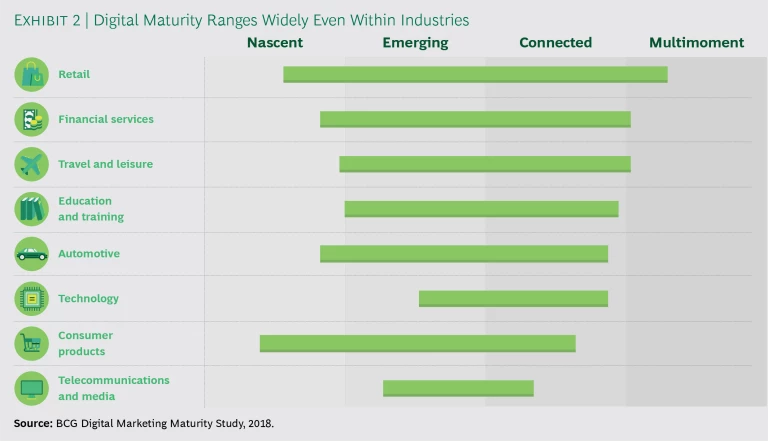The hallmark of an effective digital marketer is the ability to deliver the right message to the right person at the right time in the right place. Combining data and digital technologies can increase the relevance of advertising, services, and offers for a brand’s customers and can do so at scale. Advanced technologies that apply the latest in automation, artificial intelligence, and machine learning (ML) promise to provide powerful new capabilities—at least for marketers that know how to take advantage of them. To make the most of these advanced technologies, CMOs need the right technical and organizational success factors in place.
For organizations that improve their digital marketing maturity , and build their technical and organizational muscle, the results can be impressive. In our most recent research, companies that have achieved multimoment maturity—the ability to deliver relevant content to consumers at multiple moments across the purchase journey—reported cost savings of up to 30% and revenue increases of as much as 20%. Those that deploy ML-based technologies, with active human supervision, find that they can boost campaign performance by an additional 15%.
Companies that have achieved multimoment maturity reported cost savings of up to 30% and revenue increases of as much as 20%.
BCG and Google have collaborated multiple times over the past few years to study digital marketing. Our latest research, which was conducted throughout 2018, focused on the impact of more-mature digital capabilities (including the ability to apply advanced technologies) on the performance of individual campaigns and marketing organizations generally. (See the sidebar, “About This Study.”) Google commissioned BCG to conduct a series of tests over the past year to answer three questions related to digital marketing maturity:
About This Report
About This Report
The study consisted of multiple qualitative and quantitative components: a series of workshops and interviews to define a framework for digital marketing maturity, “belief audits” with about 40 experts to test the framework and the enablers that support it, and surveys of senior marketers of more than 200 global brands in ten industries. We also conducted 16 tests with six large brands from four European markets (France, Italy, Spain, and the UK) to assess the value that companies realize by applying more-advanced technologies. We tested the impact of commonly available technology features that are important for technical maturity, such as advanced audience targeting, automated bidding and automated creative optimization, and data-driven attribution.
To run these tests, BCG worked with agencies and advertisers to design, set up, and execute controlled experiments over a four- to six-week period, using a consistent method and measurement approach. BCG supported the agencies’ execution of the campaigns, including weekly touch points with advertisers and agencies to review results, support in-platform optimizations, ensure a consistent methodology, and assess the overall impact. The online actions or conversions to be measured were predefined on a test-by-test basis depending on brand and campaign objectives and tracked alongside operational KPIs (such as impression volumes, cost per click, and conversion rates).
The tests used a digital audience split methodology, which separates cookies into test and control groups at defined ratios using either random or geographic allocation. This creates comparable test and control groups for the purpose of the experiment. For participants using a geographic split—which allows for the measurement of offline as well as online impact—BCG defined like-for-like test and control regions according to a number of variables, such as economics, population size, and store distribution.
Participants defined the media budgets, which were then allocated to maximize statistical significance across the test and control groups and to avoid the impact of external factors such as Black Friday.
Groups were monitored and treated equally, with both the test and control groups optimized with human input in the same manner. Results were calculated over the entire test period to ensure consistency across participants; reported results were the anonymized actual results achieved, with the exception of data-driven attribution tests, which used a predictive model to forecast impact on the basis of budgets.
This report was commissioned by Google and the findings outlined herein were discussed with Google executives, but BCG is responsible for the analysis and conclusions.
- What do market leaders look like?
- What is the business value of improved digital capabilities?
- What are the best practices and the enablers that are required to achieve maturity?
Here’s what we’ve learned about how leading companies are making the most of digital engagement.
The Challenges of Consumer Engagement Today
Consumers expect digital engagement these days. Sophisticated digital marketers, such as Amazon, Netflix, and Starbucks, have trained consumers to anticipate outreach, interaction, and even personalized offers—online and offline—from brands and retailers. The best marketers now use data for end-to-end measurement and messaging to reach the right consumers. They build an in-depth understanding of the entire customer journey , and they know how and where to coordinate and focus their engagement efforts. They make data-driven and digital ways of working the norm, and they staff and organize their functions to underpin a full digital transformation.
The best marketers now use data for end-to-end measurement and messaging to reach the right consumers.
Delivering the full potential of digital engagement involves many challenges, starting with technical ones. Most marketers are not mathematicians, much less data scientists. The complexity of getting the right tech in place can be confounding, and marketers often struggle to ensure that the technology they have is properly wired together and capable of measuring impact (online and offline), preferably by demonstrating causality.
The organizational challenges are just as daunting. Agile is easier to talk about than to implement. Cross-functional collaboration does not come readily to most organizations. Digital marketing involves new ways of working, and these methods affect every staff member personally, from job description to office location to compensation. People and organizations tend to resist this kind of change, especially when it affects their own future.
The Six Enablers of Digital Marketing Maturity
Our research found that
levels of digital maturity
vary considerably among marketing organizations—as do the results that marketers achieve. Companies tend to fall into one of four maturity levels (or really one of three, since few companies have reached full digital maturity yet):
- Nascent. Marketing campaigns use mainly external data and direct buys, with limited linkage to sales.
- Emerging. Marketers make some use of owned data in automated buying, with single-channel optimization and testing.
- Connected. Companies rely on data integrated and activated across digital channels, with demonstrated linkage to ROI or sales proxies.
- Multimoment. Organizations optimize dynamic execution across channels throughout the customer journey to achieve business outcomes.
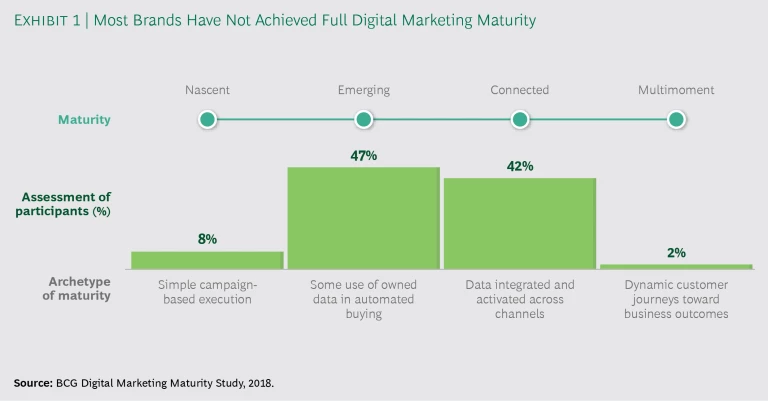
Of the 200 brands included in our survey, about 90% were split almost equally between the emerging and connected categories. (See Exhibit 1.) Clearly, marketers are trying to climb the digital curve, but the curve gets steeper as it rises, increasing the difficulty of moving to the next level. And multiple barriers hinder companies’ efforts to achieve multimoment maturity.
The companies in our study wrestled with both technical and organizational issues:
- 83% could not make connections across consumer touch points.
- 68% lacked automation, relying instead on manual processes.
- 78% could not attribute value to touch points along the customer journey.
- 80% suffered from inadequate cross-functional coordination.
In studying digital success factors, we identified six that enable a company to navigate the maturity curve, measure customer journeys, engage customers through multiple channels at opportune times, and develop personalized relationships and interactions. (See Exhibit 2.) The first three enablers are technical: connected data, automation and integrated tech, and actionable measurement. The other three are organizational: strategic partnerships, specialist skills, and agile teaming with a fail-fast culture. All are essential if a company is to reach multimoment maturity.
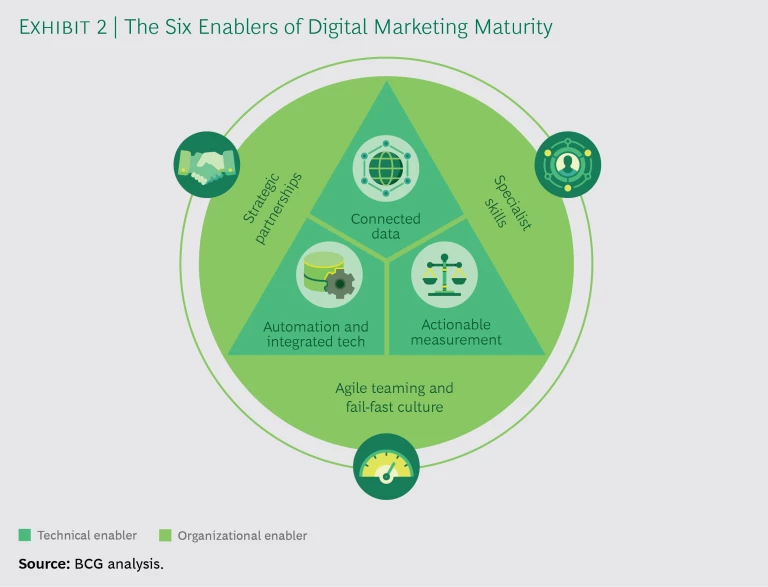
Technical Enablers
Marketers need fundamental technical capabilities to function in the digital age. These include the ability to collect and manage data responsibly, to assemble and integrate the right tech tools, and to connect initiatives with results.
Connected Data. Mature marketers can link all their data sources, online and offline, to define their target audiences and build a complete customer picture. In the digital age, connected and secure data is essential, not only to marketing but also to applying new technologies to a host of business needs and functions. For example, the finance subsidiary of a large European retailer established a unified data platform for the company’s 16 million loyalty program members. The platform securely houses company data (from transactions as well as onsite and offsite activity) and third-party data in one place. The company has halved its online credit card application journey from eight screens to three and now offers differentiated products, including price-advantaged loans, to program members.
Automation and Integrated Tech. Companies today use an array of marketing technology tools that permit automation of data and content at scale. The required tools include a web analytics capability, a CRM suite, and integrated advertising technology for automation of media buying and message tailoring. These technologies open up a world of possibilities. For example, when an online travel company partnered with a technology provider to use insights from data and automate programmatic display, its display advertising team freed up 80 work hours per day and its data preparation time decreased by almost 100%.
Actionable Measurement. Data-driven marketers can identify the value of touch points along the purchasing journey to inform KPIs and link these engagements to business outcomes such as sales and profit impact. These marketers understand what their customers want, where they stand on the purchasing journey, and why they buy what they buy. An automaker installed data-driven attribution technology to better understand customer journeys and used the resulting insights to inform budget allocation and smart bidding strategies. It improved lead volume by 6% and cost per lead by 17%—and it generated about 15% of its leads from mobile, demonstrating the efficacy of a new marketing channel for the company.
Automatic Improvement
To quantify the value of improving digital maturity, we tested the impact of some of the most advanced commonly available ML-based technology on the three technical enablers. We used test-and-control experiments involving six large brands across Europe in the finance, automotive, and retail industries. In our tests, advertisers and agencies applied automated bidding in order to dynamically adjust their bids for impressions that promise a high chance of conversion. They automated the selection of creative treatments according to which would generate the most conversions. Advanced targeting dynamically identified audiences who used particular defined behaviors or demonstrated purchase intent. Using data-driven attribution, advertisers credited revenue across channels and devices according to the impact each had on sales.
The study showed that the application of ML-based technology made material differences in delivering the right message to the right person in the right place at the right time—in ways that traditional techniques did not. We found quick and significant improvements in both efficiency and effectiveness from the implementation of advanced technologies to common digital advertising and marketing processes. Over four to six weeks, we measured reductions of more than 40% in cost per action (CPA) and increases of up to 50% in online transactions.
Our tests found that, in addition to reducing CPAs and increasing online transactions, advanced technology improved return on advertising spending (ROAS) by up to 33% for the participating brands. Many saw rapid operational improvements from automation because the ML algorithms are designed to learn quickly—within a few days or weeks. One automaker found that it needed to manually optimize its campaigns for only 4 factors, instead of the previous 13, and it reduced its workload by two-thirds.
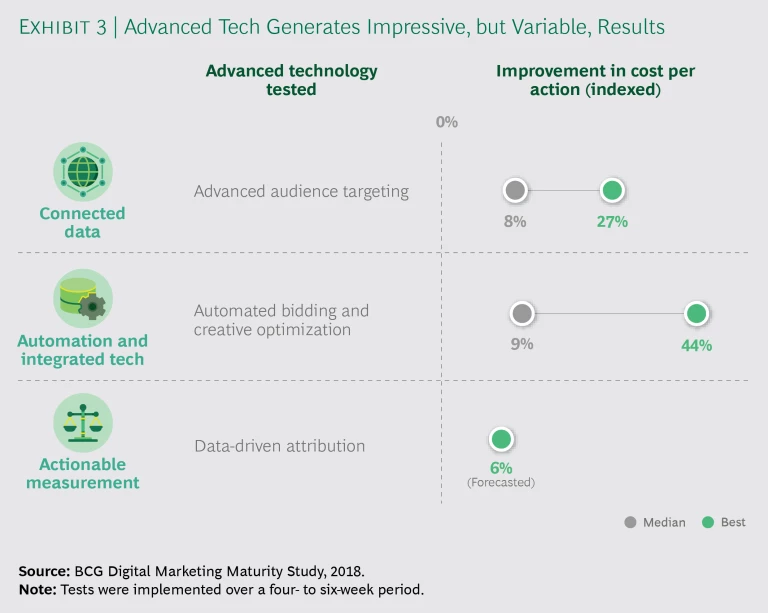
But the results also showed wide variation. (See Exhibit 3.) For example, advanced audience targeting resulted in a drop in CPAs ranging from a median of 8% (not bad) to 27% (a pretty big deal). Similarly, automated bidding with artificial intelligence reduced CPAs by a median of 9% (okay) to 44% (really good) depending on the company and test. The difference lies in human intervention.
The Human Boost
Marketers typically improve their digital campaign performance over time by learning best practices and optimizing settings. Our research showed that, because advanced technologies are quicker than people to identify and correct the reasons for underperformance, these technologies provide an average performance boost of 20%. But it takes humans and a test-and-learn approach to apply strategic considerations and adjust for compatibility factors that algorithms have difficulty seeing. On average, human adjustments can add another 15%, on top of the 20% technology-driven improvement, to campaign performance. (See Exhibit 4.)
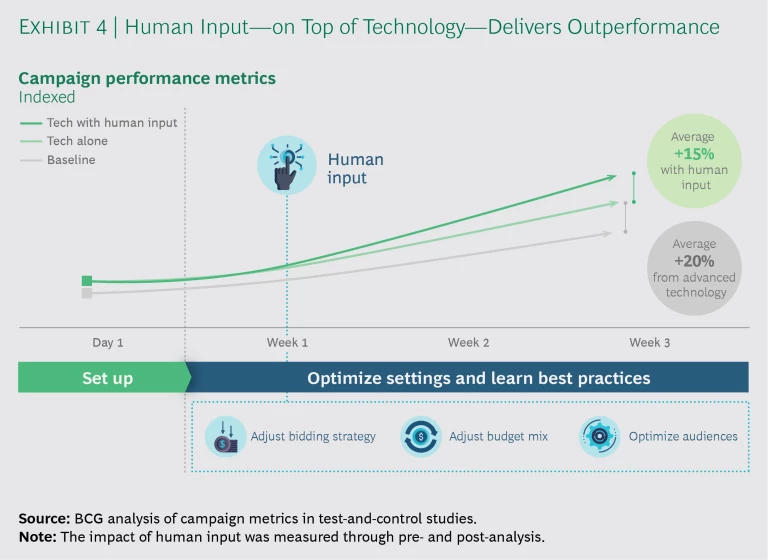
Human input can help improve campaign performance in three areas. First, by aligning campaign objectives and technology settings (such as bidding strategy and definition and measurement of the consumer action desired), marketers can increase their reach and reduce CPAs. Second, adjusting the mix of channels or devices for category compatibility (to account for product seasonality or how a particular touch point fits into the purchase cycle) increases conversions and accelerates ML. Third, aligning the selection of audiences and messages with customer journey stages improves both effectiveness and efficiency.
In our tests, the combination of advanced technologies and human adjustments reduced CPAs by twice as much as the control group by optimizing spending on the higher-performing in-market audiences. Revising the channel mix produced an even result between the test and control groups. But by adjusting the bidding strategy to prioritize efficiencies, brands achieved an improvement of 50%.
Consider three examples from our study. One large retailer and its online agency conducted geographic tests across the UK to measure the online and offline sales impact of advanced audience targeting according to user interest in a category. The tests demonstrated that use of the advanced technology produced an immediate material improvement in search campaign metrics across user engagement, online transactions, and CPAs. They also showed a correlation between online and offline performance, with an uplift of about 1% in offline sales value. When marketers intervened and adjusted the campaign strategy, they more closely aligned category dynamics and customer journeys, focused on the highest-performing customer groups, and reallocated budgets to the mobile devices with the highest revenue results. These moves, combined with the boost driven by technology, realized a 30% to 50% overall improvement in conversion rates, up to a 30% improvement in CPA, and a doubling of ROAS.
Human input drove an additional 20% improvement in conversion rates and a 5% to 10% improvement in CPAs.
In another test, an automotive brand aimed to increase engagement across its display campaigns in order to generate more high-quality visits to its website. The company defined custom audiences to identify customers with purchasing signals that indicated interest in buying a new car (people searching for new cars, visiting dealership websites, or researching related brands, for example); it compared those audiences with purely sociodemographic audiences (which were based on customer-provided age and income information). Tests showed immediate improvement over the control group. After about ten days, conversion rates doubled and CPAs were down about 25%.
Human input further improved campaign performance by adjusting both the target custom-audience signals and bid thresholds and the strategy. This drove an additional 20% improvement in conversion rates and a 5% to 10% improvement in CPAs. Overall, tests showed material improvement in both effectiveness (42% more conversions, 10% more high-quality website visits) and efficiency (27% lower CPAs). The automaker plans to further test these advanced custom audiences on other campaigns and brands in an effort to identify best practices that can be scaled.
In a third test, a UK do-it-yourself chain saw a 9% improvement in CPAs with human input reallocating budget and automating creative optimization in ways that focused spending on the better-performing messages for each audience. The technology also helped the advertiser identify that project-based messages were more effective than product-focused creative content with the target audience.
Organizational Enablers
A big part of the human boost to campaign performance lies in the organization’s ability to support and enhance the performance of technology consistently across brands and campaigns. Among the 200 brands that we observed, we found that the more the marketing organization can apply organizational best practices, the more it can add significant scale to the impact of advanced technology on campaigns. In fact, companies with high organizational maturity reported 1.4 times the impact on costs and 2.5 times the impact on revenue compared with low-maturity marketing organizations. We identified three key organizational enablers for digital marketers.
Strategic Partnerships. Technology is about ecosystems. Few companies, even digital natives, go it alone. The key for marketers is to collaborate effectively with agencies and marketing tech providers while maintaining direct control over technology and first-party data. One automaker established a marketing hothouse where about 150 people, including staff from four agency partners, work in the same building alongside members of the OEM’s marketing and media teams. This approach puts all the expert disciplines (creative, content, operational, social media, and others) in a single place. The company has standardized ways for its agencies and marketing team to collaborate on campaign development, including performance reviews against predefined shared marketing objectives as well as budget, quality, and timeliness criteria. Among the benefits: increased agility with improved capacity planning and speed to output.
Specialist Skills. The best performers identified, hired, and trained technical talent, such as in-house data scientists and measurement experts, and also integrated these people with other members of the marketing staff to produce effective cross-functional teams. The lack of organizational connection between branding and online-marketing staffs led one online retailer to establish multidisciplinary marketing teams in which experts could work together closely to create one experience for customers. Each team includes specialists in brand marketing communications, customer insights, shop management, programmatic advertising, shop marketing, and marketing intelligence (data scientists) who advise the rest of the team on data and performance.
Agile Teaming with a Fail-Fast Culture. The most mature marketers in the study embraced a fail-fast, test-and-learn approach in which they identify failures early, learn the appropriate lessons, and move on. Done right, an agile transformation affects everything from internal processes to how employees spend their day to how people in the organization interact. Because most established organizations favor the status quo and fear change, it is not unusual for them to try to kill the transformation before it can gain traction. To prevent this from happening, C-suite sponsorship is essential, as is the active cooperation—and often the physical presence—of corporate functions such as HR, legal, and finance. For most companies, making the agile transformation is the most difficult step to take, but it’s also the one that brings all the others together.
A Roadmap to Maturity
Technology can give a quick boost to results, but long-term improvement requires more far-reaching organizational change. (See Exhibit 5.) Marketing organizations that want to make the shift will need determination and persistence, but as the best-in-class marketers have shown, the payoff is worth it.
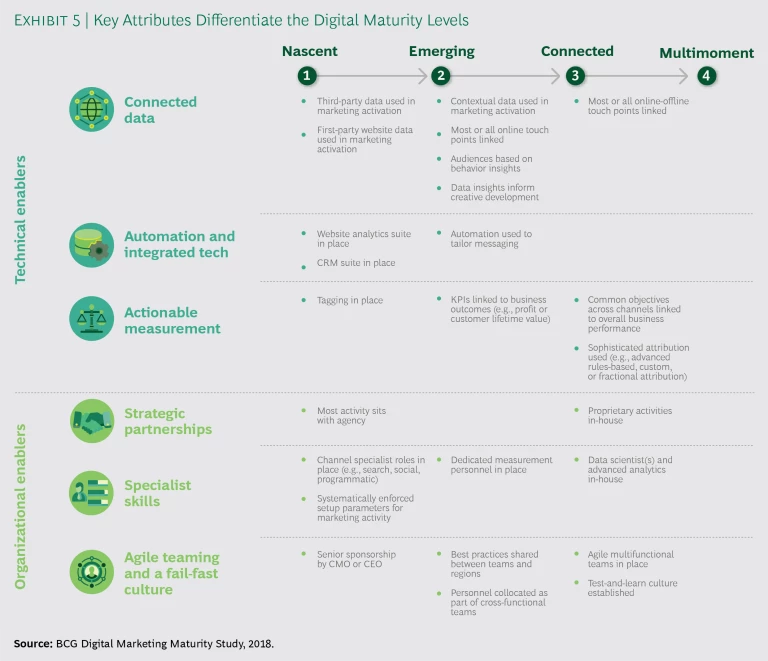
Having a roadmap helps. On the basis of our research, we have identified the pathway and attributes that brands typically acquire to move forward on the maturity curve. The roadmap has three stages, and—as with the enabling factors—there are both technical and organizational milestones to achieve at each stage.
From Nascent to Emerging: Set the Foundation. Best-in-class marketers have overcome the challenges of changing how their people work. Such a transition typically requires an active and visible C-suite sponsor. It also demands the involvement and cooperation of internal and external partners. HR must help design new career paths and incentive schemes, for example. Legal must agree to new ways of reviewing and approving campaigns and data collection. The company will probably have to bring external agencies and their expertise onboard to fill gaps in internal capability (although, ironically, this is often easier than securing cooperation in-house).
On the technical side, responsible data analysis is the foundation of digital engagement, but many marketing organizations lack regular access to sources of trusted and transparent data about customer behavior on their sites (such as clicks on websites, page views, and conversions). Furthermore, they lack the robust analytical capabilities that can turn data into plans, programs, and initiatives. Without such data-related capabilities, they have little hope of reaching the next stage: becoming connected.
From Emerging to Connected: Build Connections. The second stage of the journey to digital maturity involves building the cross-functional connections that make digital organizations work. Companies can demonstrate progress by starting to coordinate multiple channels, drive incremental revenue, and achieve efficiencies through better media execution. Most successful companies establish cross-functional teams (which they will need anyway when they move to the next maturity stage) that combine the relevant expert disciplines—creative, content, operational, and social media, for example—and bring together offline channels and online marketing to work more closely together. Some put their teams in the same location, as the automaker did in establishing its cross-functional hothouse. These teams work toward common KPIs and are often supported by dedicated measurement experts.
Crucial at this stage are the technical abilities to combine internal and external sources of online data in order to provide insights about audiences and to inform creative work, and then to automate messages for fast campaign development, testing, and adjustment. For example, companies link most or all of their online data, engage audiences on the basis of insights about their behavior, automate message tailoring, and link KPIs to business outcomes. Applying ML-based technologies helps automate deployment and realize efficiencies in execution.
From Connected to Multimoment: Make Every Moment Count. The final stage of marketing maturity is the most difficult. Acting on relevant customer touch points in a coordinated and sequenced way involves integrating key proprietary capabilities, such as an advanced analytics team, into the organization and also embedding agile teaming—without that, it’s virtually impossible to move at digital speeds. This is where many companies stumble, leaving them with an organization that is agile in name only or that has adopted half measures. They may be successful at cross-functional reorganization, for example, but fall short in following through with redesigned career paths and incentive programs based on shared objectives. They may have a bank of data scientists and measurement experts but fail to use data-driven decision making. Companies that get agile right start to market across channels and deliver better, more personalized customer experiences that drive sales. At the same time, their use of more advanced tech and automation lowers costs.
It’s essential at this stage to link technology objectives to business outcome KPIs and to use sophisticated attribution, among other measurement techniques, to optimize value. A global restaurant franchise company links offline sales to online marketing through a combination of third-party customer footfall data as a proxy for sales and store location data. A UK retailer has developed a strategic measurement plan to understand behavior and identify opportunities as a basis for deriving fast, accurate insights that can inform real-time decisions.
Getting Started
Smart companies find quick moves that they can make at each stage, often using existing data capabilities and technology, to show early progress. They build momentum, forcing practicality and helping fund the journey to the next stage. The best way to begin is by adopting a test-and-learn methodology that demonstrates the value that data-driven marketing can bring and that can accelerate achieving scale. It’s important to prioritize tests that can reveal the value of more-advanced techniques and technologies in digital marketing. Early results show progress and start to generate support.
Smart companies find quick moves that they can make at each stage to show early progress.
One way to demonstrate an early win is to focus on mastering a single channel and improving execution. The company can allow the money saved from driving out costs to drop to the bottom line, or it can reinvest the money to build new capabilities and fund additional effective campaigns. Visible results help. To show the value of digital marketing, one retailer went so far as to cease its online-marketing activity in an entire region of the country and track the drop-off in sales.
Marketers should think through how they communicate results. Building a business case around bounce rates doesn’t work in lots of traditional companies. To secure investment, show results that are meaningful to a CFO, such as the impact on sales or costs. Provide trend data that demonstrates value relative to past performance. Relate results to the success criteria used by business units and brands. Calculate the full-scale potential of the test results to show the business case for scaling up. Once you have good results in hand, don’t be shy about taking them to the C-suite. Investment in new technologies and the organizational change necessary to make the technologies work typically require senior-management support. During the later maturity stages, the investments in expertise and enablers will pay off with the ability to mount personalized campaigns at scale and build customer relationships that deliver increased loyalty and revenue.
They say that growing up is never easy—and when it comes to digital marketing, they are right. But our tests showed that making headway in a few weeks is possible with the right conditions. Advanced technology can drive rapid business performance and improved marketing maturity. But it takes human supervision to achieve maximum impact. Most marketers still need the technical and organizational enablers in place to achieve multimoment marketing maturity. Individually, each of the enablers provides a powerful increase in capability. The combination of all of them defines full maturity and makes marketing organizations capable of engaging customers at every stage of the purchase journey—and of building lifetime customer relationships.
Maturity has its advantages. The sooner marketers start (or accelerate) their journey to digital maturity, the sooner they will see the benefits to their business begin to accrue.


